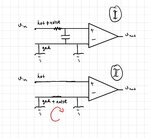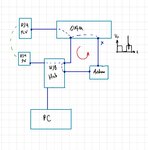doncarlosalbatros
Full Member level 2
This is a conceptual question about opto isolators couplers and their use in pulse or digital signals.
In a single ended transmitter receiver system for digital signals if the noise is at the signal line(hot), then low pass filter is used to mitigate the noise as in Figure 1 below:

In such system if there is EMI or a noise that would also bounce the ground RC filter will not help since the noise is also at the ground line as shown in red loop in Figure 2 above.
Are opto isolators used in such cases? Is the idea to break the loop and prevent the EMI to induce a looping current?
Im trying to understand why or when the opto isolators should be used and how does it prevent the interfernce caused noise.
In a single ended transmitter receiver system for digital signals if the noise is at the signal line(hot), then low pass filter is used to mitigate the noise as in Figure 1 below:

In such system if there is EMI or a noise that would also bounce the ground RC filter will not help since the noise is also at the ground line as shown in red loop in Figure 2 above.
Are opto isolators used in such cases? Is the idea to break the loop and prevent the EMI to induce a looping current?
Im trying to understand why or when the opto isolators should be used and how does it prevent the interfernce caused noise.
